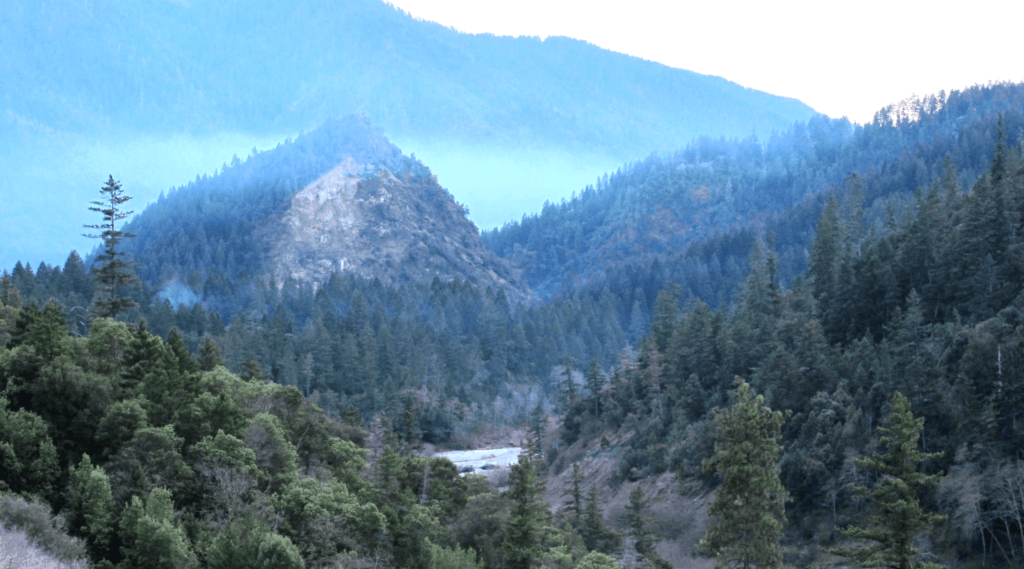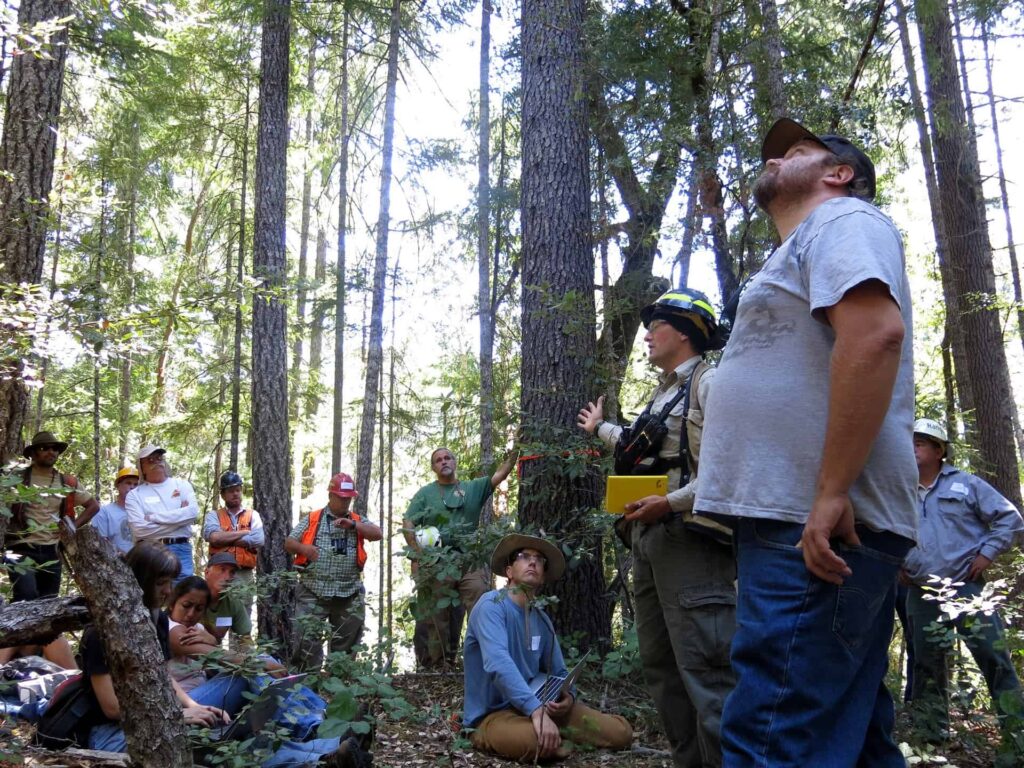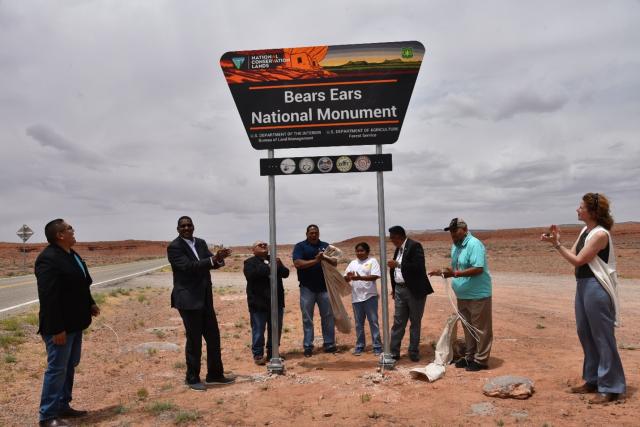New guidelines require federal agencies to include Indigenous knowledge in research, policy and decision making. What does this newfound respect mean for tribes? We begin a three-part series by looking at opportunities for tribal-federal cooperation in land management.
By Melanie Lenart

It’s been a long and rocky road to forest co-management for the Karuk Tribe. With most of their traditional homelands designated as part of California’s Klamath National Forest, the Karuk have been working to re-establish cultural burning there since they became a federally recognized tribe in the 1970s.
Along the way, they’ve been threatened with arrest for pursuing practices covered in agreements made with the US Forest Service and watched the partial razing of an area they had specifically identified as sacred, provoking a lawsuit against the federal agency.
After this rocky start, however, things are looking up for the Karuk’s plans to bring back intentional fire into some of their ancestral lands in the national forest system.
The tribe is one of many featured in the Guidance for Federal Departments and Agencies on Indigenous Knowledge released jointly by the Council on Environmental Quality and the Office of Science and Technology Policy in late 2022. Among other things, the memo’s 25-page Appendix summarizes case studies of various projects and provides links to protocol adopted by specific agencies. The 21-page policy document urges US agencies to recognize Indigenous knowledge as high-quality science and encourages them to co-manage public lands with tribal nations.
The ups and downs of the Karuk Tribe’s travails in working with federal agencies, not an uncommon experience for tribal nations, may help explain why many are greeting this ground-breaking memo with cautious optimism, while acknowledging that it’s a big step in the right direction.
Indigenous knowledge recognized as science
“I was pretty pleased when I saw the actual guidelines come out,” said Michael Kotutwa Johnson, University of Arizona researcher specializing in Indigenous resiliency. “For right now, it’s good because it brings recognition to our ways of knowing as being science. So that opens us up more to funding opportunities in the area of conservation and in land management.”
Johnson was one of the approximately 1,000 people the memo said participated in Indigenous knowledge guidelines hearings throughout 2022. He has been urging the need for change since at least 2004. During a research stint with the USDA Natural Resources Conservation Service that year, he discovered that the traditions he inherited from his Hopi ancestors didn’t count to the agency as “quality” science, despite their proven ability to grow corn and other staples in the sparse rainfall conditions of what is now Arizona.
In 2021, Johnson published a Journal of Soil and Water Conservation article with colleagues arguing that the conservation service should credit Indigenous knowledge as equivalent to other practices described in the agency’s technical guides when it comes to awarding financial incentives for sustainable agricultural practices.
The guidelines released in November aim to do just that. The policy memo elevates Indigenous knowledge so it holds its own in federal decision making.
“Indigenous Knowledge is a valid form of evidence for inclusion in Federal policy, research and decision making,” the Nov. 30 memo states, noting it no longer depends on validation from other forms of knowledge. “The guidance is founded on the understanding that multiple lines of evidence or ways of knowing can lead to better-informed decision making.”
The guidance focuses on co-management of public lands and co-production of Indigenous knowledge, encouraging federal agency employees to engage with tribal nations responsibly and with respect. It highlights the need to go through official leaders of tribal nations when forging agreements or passing memorandums of understanding. It explains that developing these relationships takes time, and that moving ahead with knowledge exchange should follow agreement of official arms of the tribal nation.
Among other specifics, the guidance recommends that agencies seek out Indigenous knowledge when considering listings under the Endangered Species Act, authorization regarding public lands under the National Environmental Policy Act, and recognition of religious and cultural significance under the National Historic Preservation Act of any properties eyed for development or other uses.
Acknowledging past injustices
The Indigenous knowledge document asks federal employees to acknowledge past injustices carried out by their agencies or the federal government in general when attempting to engage with tribal nations. For instance, it points out that US scientists and medical providers used the “pseudoscience of eugenics” (now discounted by the scientific community) to carry out the forced sterilization of Indigenous women across the nation.
The Havasupai tribe once learned of an illicit use of blood samples from its members for purposes other than an agreed-upon diabetes study. Even well-intentioned researchers often neglect to follow up with promised knowledge sharing. The past injustices include systematic separation of tribes from their traditional lands.
“Historically, Federal policies have resulted in the separation (both physically and intellectually) of Indigenous Peoples from the places they are connected to, severing relationships with lands, waters and social systems, which are all critical elements of Indigenous Knowledge,” the guidance document states. “However, Tribes and Indigenous communities have demonstrated remarkable resiliency in maintaining and continuing to develop Indigenous Knowledge, which has existed since time immemorial and remains strong today.”
Agencies should be aware of the unique connections many tribes and Indigenous peoples have with their traditional homelands, even if they were forcibly removed from them, the document states. “These resources may be necessary to Tribal and community health and wellbeing in ways that Agencies may not fully understand.”
‘Uneven’ efforts on collaboration
As the guidance document also points out, efforts to incorporate Indigenous knowledge and collaborate with tribal nations has been “uneven” and often dependent on specific individuals in federal agencies.
That helps describe the situation of the Karuk tribe, based on the input of Bill Tripp, director of the tribe’s Department of Natural Resources. After learning from his grandmother about cultural burning practices since he was 4 years old, Tripp has been working since 1993 on nation-to-nation coordination efforts for managing the Klamath and Six Rivers national forests—which contains 98 percent of the tribe’s original homelands.
He and others worked out agreements with a district ranger to conduct cultural burning within the national forest. Yet when leadership changes led to turnover, the new district ranger threatened tribal members with arrest if they attempted to carry out the plans made under an initial agreement.
When the opportunity arose again in the 2000s, they worked with federal agencies to develop policy on fishery-related issues, with some success. But challenges blocked efforts to come to agreement for dealing with the overly abundant trees and brush that were making the forest more susceptible to out-of-control wildfires.
Of particular interest was an area known as the Panamnik World Renewal Ceremonial District, a sacred site used since time immemorial for renewal ceremonies, known to the Karuk as Pikyávish.
“We had made agreements that they wouldn’t start on our ceremonial trail and that they wouldn’t do damage to the sites and the features of our ceremonial landscape,” Tripp said in a phone conversation. “And, you know, the first thing they did is they went right there and they started putting (bull)dozers on there. So it was like, ‘what are you guys doing? Are we just identifying things so you can damage them?’”
The Karuk Tribe sued the forest service in 2010 to stop the logging. The judge eventually sided with the tribe. The court provided a remedial plan in order to improve the relationship. More years of stalemate followed as they considered how to move forward. After years of preparation, they formed the Western Klamath Restoration Partnership in 2014. Despite their efforts at collaboration, they reached an impasse on how to treat the land to improve resiliency to the large-scale wildfires ravaging western forests

“There was nobody willing to budge in that conversation,” Tripp said. “Half the room believed that all you could do is cut timber, and the other half of the room believed there was no way we were going to cut our way out of the problem and we have to be putting fire back in the system.”
The partnership’s co-leaders were ready to throw in the towel. But a meeting with some people from The Nature Conservancy’s international fire program led to the non-profit conservancy stepping in to facilitate discussion.
“Instead of coming into a conversation with people trying to defend their space, people were guided to consider how our values overlapped,” he explained. “That opened up a lot of room to ultimately understand others’ positions, and how it didn’t have to be this or that. It ultimately ended up having to be both. That was kind of a defining moment.”
Indigenous agency workers prove key
Their hard-won agreement languished while waiting for a response from relevant leaders in the Forest Service. Finally, Nolan Colegrove, a newly hired employee with the Six Rivers branch of the forest, reached out to propose collaborating toward cultural burns by filing the necessary paperwork—namely, the environmental assessments required under the National Environmental Policy Act.
“He came in as an Indigenous person from the area, from an adjacent tribe, so he understood,” Tripp said. Briefly, another Indigenous worker familiar with cultural burns joined Colegrove as a forest line officer. “They were able to help champion that in their agency.”
Still, things went on hold again in 2017. Tripp and his team shifted their focus to working with state officials. That effort is paying off, with the California legislature allocating $2.8 billion for efforts to make the Klamath and Six Rivers national forests more resilient to wildfires. Some of this funding will cover the plans created by the partnership. The partnership itself also has received two $5 million grants.
The money is flowing at the federal level again now, too. The Forest Service now has $3.5 million for tribal forest protection under the Biden administration’s Infrastructure Law. And the agency’s Six Rivers branch just secured another $8.5 million from the Biden administration’s Inflation Reduction Act, much of which will also go for the restoration projects identified as priorities by the partnership.
It took a good three decades, but the cultural burnings long envisioned by the tribe seem poised to happen. Instead of the few hundred acres they were exploring in their initial collaboration, they now assess blocks of 5,000 acres for projects. They have environmental assessments ready to go for some limited logging followed by cultural burns on 10,000 acres.
In a blog for the Fire-Adapted Communities Learning Network, Tripp described a vision where a series of cultural burns restore black oak woodlands, with madrones, Douglas firs and pines dotting the landscape. Salmon, deer, elk and acorn trees flourish, with abundant black-cap raspberries and healthy hazel sticks for basket weaving.
“The only difference with this vision now is that it appears to be feasible,” he writes.
Co-managing Bears Ears National Monument
Five other tribes are now co-managing public lands as part of an agreement reached in June regarding Bears Ears National Monument, located in southeastern Utah. Forest Service and Bureau of Land Management officials signed an inter-governmental agreement with officials from the Hopi, Navajo, Pueblo of Zuni and two Ute nations to cooperatively manage the 1.36 million-acre national monument.
All parties agree to cooperate in decision making, land planning, and program development; engage in ongoing knowledge exchanges on topics including protecting “both visible and sacred Tribal uses and activities”; work collaboratively to ensure Tribal Nations have access to sites for gathering plants and firewood as well as other cultural purposes; meet quarterly for consultations and annually to set work plan priorities based on available funding. The document specifies that the agreement comes with no funding to support these activities, something that Hopi farmer and university researcher Johnson found odd.

“The Whole Bears Ears National Monument is a great thing but I’m surprised it’s not even funded,” he said. It costs money and time to hold meetings, especially when participants are often traveling to or from remote locations. “How much actual management, on-the-ground management, will tribes be doing? Are they going to hire a bunch of new park rangers from tribes?”
Johnson said he would have to watch how the co-management panned out before drawing conclusions on whether the partnership has teeth over the long term.
As it is, the Obama administration issued an executive order giving the Utah-based Bears Ears lands national monument status, which comes with some protection from development. But the Trump administration reversed the executive order. When the Democrats regained the White House in 2021, officials restored national monument status and added the layer of co-management—also by executive order. As the Bears Ears monument saga illustrates, these presidential orders are not the most stable way to protect public lands, whether sacred or mundane.
Under the intergovernmental agreement guiding the Bears Ears cooperative management, the five tribal nations, including the Ute from Ute Mountains and those of the Uintah and Ouray Reservation, work together in the Bears Ears Commission. Commission co-chair Carleton Bowekaty, lieutenant governor of Zuni Pueblo, shared some thoughts on this in a statement.
“Today, instead of being removed from a landscape to make way for a public park, we are being invited back to our ancestral homelands to help them and plan for a resilient future,” Bowekaty stated, noting that challenges include tourism, erosion and drought. “We are being asked to apply our traditional knowledge to both the natural and human-caused ecological challenges.”
Now that the promise of including Indigenous peoples with passed-down knowledge of their traditional lands has become federal policy, the type of co-management found in Bears Ears National Monument and Klamath National Forest may become more commonplace.
• • •
EDITOR’S NOTE: This is the first in a series of articles considering the impacts of the federal guidelines on Indigenous knowledge. This one focused on the co-management of public lands by tribal nations alongside federal agencies. The next article will consider co-production of Indigenous knowledge, including options for tribal nations and those working with them to help protect tribal data sovereignty. A third article will consider these guidelines and technological advances in the context of traditional agriculture and heirloom seeds.
Other Native Science Report articles addressing this topic
A New Era for Tribes
https://nativesciencereport.org/2021/11/a-new-era-for-tribes/
Indigenous Knowledge Goes to Washington
https://nativesciencereport.org/2022/02/indigenous-knowledge-goes-to-washington/
Using, not Losing, Indigenous Knowledge
https://nativesciencereport.org/2022/10/using-not-losing-indigenous-knowledge/
Melanie Lenart is a regular contributor to Native Science Report
Story published February 22, 2023
• • •
Enjoyed this story? Enter your email to receive notifications.
